Completes six years of dedicated service to customers
Picanol has set a perfect example of what it takes to succeed in a market like India. The company has today emerged as the largest  supplier of weaving machines in the Indian market. But to reach this position of leadership meant decades of commitment to quality, performance and, most importantly, a single-minded focus on servicing the customer.
supplier of weaving machines in the Indian market. But to reach this position of leadership meant decades of commitment to quality, performance and, most importantly, a single-minded focus on servicing the customer.
Picanol has been present in the Indian market for many decades. Identifying a growing opportunity, and with an intention to stay closer to its customers, the Group started its Indian operations in 2008 under the leadership of Mr. P. Kasiviswanathan who had nearly two decades of experience selling its machines in India.
With over 17,000 Picanol weaving machines operating at customer locations across the country, the company is quite optimistic about the future growth opportunities in India. Picanol’s success is attributed to the commitment of the company’s management team in Belgium, headed by its CEO, Mr. Luc Tak, coupled with the hardwork and dedication of its Indian team. As Picanol India completes six successful years in India, Mr. Kasiviswanathan, Head of Indian Operations, recollects on the journey so far and factors that would propel the next phase of growth.
Question: It’s been six years since Picanol started its operations in India. Can you recollect the journey so far? What were the key milestones in this six-year journey?
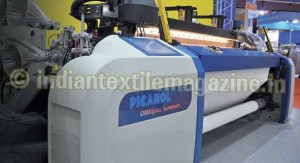 Answer: At the beginning of this century, it became clear that India had the potential to become one among the top three players in weaving. The large local availability of cotton, a large and modernizing spinning industry, skilled and affordable labor force, rich textile tradition, growing local consumption due to a rapidly growing middle class and a still moderate share of exported textiles, all gave this clear indication. As Picanol wanted to have its presence in every key market, it became obvious that Picanol India had to be set up. The first objective was to improve the technical services offered to customers. In a second line, starting direct relations would bring us a better understanding of Indian customers, allowing us to offer products and services tailored to their needs.
Answer: At the beginning of this century, it became clear that India had the potential to become one among the top three players in weaving. The large local availability of cotton, a large and modernizing spinning industry, skilled and affordable labor force, rich textile tradition, growing local consumption due to a rapidly growing middle class and a still moderate share of exported textiles, all gave this clear indication. As Picanol wanted to have its presence in every key market, it became obvious that Picanol India had to be set up. The first objective was to improve the technical services offered to customers. In a second line, starting direct relations would bring us a better understanding of Indian customers, allowing us to offer products and services tailored to their needs.
We have to admit that the first year of operations was difficult, as it coincided with a worldwide crisis and slump in demand. But ever  since, it has been going upward. We started with three offices and a small but dedicated sales and technical staff, well experienced and trained in our headquarters in Belgium. In parallel with the market growth, we continued to invest in more manpower, and simultaneously invested in improving their skills level. As for the print repair station, our customer base kept expanding year after year, and more and more customers started taking our technical support. Our customers soon understood the advantages of buying original spare parts, guaranteeing optimal performance and lifetime of their equipment. The result: widening loyal customer base, which nevertheless is prompting us day after day to improve performance of our products and services.
since, it has been going upward. We started with three offices and a small but dedicated sales and technical staff, well experienced and trained in our headquarters in Belgium. In parallel with the market growth, we continued to invest in more manpower, and simultaneously invested in improving their skills level. As for the print repair station, our customer base kept expanding year after year, and more and more customers started taking our technical support. Our customers soon understood the advantages of buying original spare parts, guaranteeing optimal performance and lifetime of their equipment. The result: widening loyal customer base, which nevertheless is prompting us day after day to improve performance of our products and services.
Q: How is the growth of the weaving industry in India in the last few years and what are the key growth drivers in the future?
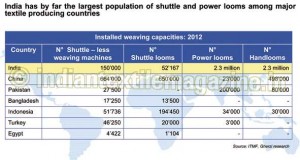 A: I would say the domestic market in weaving really started expanding in the last five years or so. It has also much to do with the growing household income level and more disposable income, as well as general fashion consciousness. The demand for higher domestic fabrics quality level has also gone up, and even the decentralized segment started focusing on product quality rather than quantity. The denim, shirting and even sheeting market expanded exponentially over these years, and denim has now become more of daily wear than seasonal demand. More and more international brands started entering India and the growth in the number of new retail chains is attributed to the expansion of the textile sector which is one of the major contributors to the national GDP. On top of that, the growing export share was a major driver for expansion.
A: I would say the domestic market in weaving really started expanding in the last five years or so. It has also much to do with the growing household income level and more disposable income, as well as general fashion consciousness. The demand for higher domestic fabrics quality level has also gone up, and even the decentralized segment started focusing on product quality rather than quantity. The denim, shirting and even sheeting market expanded exponentially over these years, and denim has now become more of daily wear than seasonal demand. More and more international brands started entering India and the growth in the number of new retail chains is attributed to the expansion of the textile sector which is one of the major contributors to the national GDP. On top of that, the growing export share was a major driver for expansion.
Q: How has Picanol helped change the weaving industry landscape in India over the last six years?
A: It has always been the tradition of Picanol to be a front-runner in technological innovation of weaving machines. We keep investing 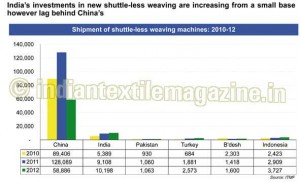 in R&D with a special focus on customer benefit along our five base lines: help our customers to get the maximum out of their market, time and people, and at the same time reduce waste and energy consumption. We have explained these ideas at the exhibitions and seminars during visits to our customers and have convinced a number of entrepreneurs to move up a level into higher performance machinery – in other words, ‘Technological Upgradation’.
in R&D with a special focus on customer benefit along our five base lines: help our customers to get the maximum out of their market, time and people, and at the same time reduce waste and energy consumption. We have explained these ideas at the exhibitions and seminars during visits to our customers and have convinced a number of entrepreneurs to move up a level into higher performance machinery – in other words, ‘Technological Upgradation’.
Q: How has Picanol India performed in 2013? How is the growth compared to the previous year?
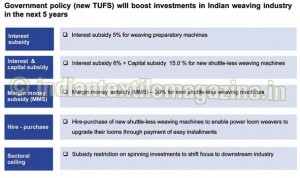 A: Even though we had suspension of TUFS in March and then INR started becoming weak against the Euro and domestic demand for fabrics started going down, we did extremely well in 2013, thanks to the repeat orders from our existing customers who gave us unconditional support. We did also get some of the major orders from big textile groups during the year, confirming our technological leadership. We did achieve significant growth compared to the previous year due to new market segments explored over and above the repeat orders, thanks to our new airjet OMNIplus Summum and the well-proven OptiMax high-speed rapier.
A: Even though we had suspension of TUFS in March and then INR started becoming weak against the Euro and domestic demand for fabrics started going down, we did extremely well in 2013, thanks to the repeat orders from our existing customers who gave us unconditional support. We did also get some of the major orders from big textile groups during the year, confirming our technological leadership. We did achieve significant growth compared to the previous year due to new market segments explored over and above the repeat orders, thanks to our new airjet OMNIplus Summum and the well-proven OptiMax high-speed rapier.
Q: You once mentioned that only two per cent of the total looms in India are new generation looms and the rest are either second-hand or old looms. With higher Government support and incentive, do you see this scenario changing?
A: TUF benefits are already with us:
The table gives updated figures indicating that only 4.4 per cent of the fabrics are coming from the organized sector and a large amount 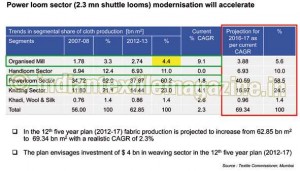 is produced by the powerloom sector.
is produced by the powerloom sector.
The recent TUF benefits from Central and State Government will encourage the industry to go for new looms even for mid-segments that have been using second-hand looms. Of course, it takes time but the first powerloom sector will move to the auto loom and then second-hand shuttleless looms and new high-speed shuttleless looms.
Q: An important reason behind the successful performance of a machine is its aftersales service support. What is Picanol’s current infrastructure and what are the investments planned to further improve on this infrastructure?
A: Aftersales service is one of the major criteria Indian customers consider while making their investment decisions. The local presence of Picanol India has been a decisive factor in the choice of many customers.
We have invested in a new corporate office in Delhi with a state-of-art electronic print repair facility. The workshop has been upgraded with the latest test system for new OMNIplus Summum looms supplied in India. We have also expanded our service network and sales force keeping in mind the future potential of the Indian market. The Picanol Group has its strong belief in the growth of the Indian market, in the coming years.
Q: Personally, you have been associated with Picanol for the last couple of decades and more directly heading the Indian business in the last six years. How enriching and satisfying has the experience been? What is the vision and the mission you have set for Picanol India in the next few years, say, by the completion of 10 years in the Indian market?
A: Well it has been so far 21 years of association with Picanol, and I have to say I have grown with the company and the market. It has been a satisfactory journey overall when you see the company evolving over a period of time, and the presence in the Indian market has also kept increasing with greater market penetration achieved.
Picanol has been able to prove to India over these years that we are a reliable partner. Our aim is to give our customers the maximum benefit out of market, material, energy, talent & time through our machines. Our new products are always based on customer needs. Our prime target is to keep pace both in manpower and skill development to offer top service to the more than 17,000 Picanol looms already running in India, and many more to come.